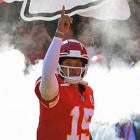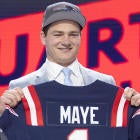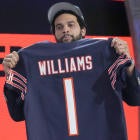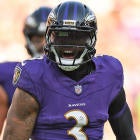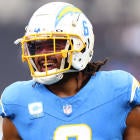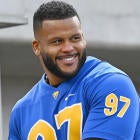Letting the past die, welcoming new heroes into our lives to replace the ones of our youth, and willingly admitting the present might be as good as -- if not better than -- the past is never an easy process, and it won't be any different for the NFL once the likes of Tom Brady, Aaron Rodgers, Drew Brees, and so on are forced to move on from a sport they shaped. But the NFL can rest easy at night knowing the future isn't dark and full of terrors.
The future is bright. More importantly, the future has already arrived.
Welcome to our annual Top 25 NFL Players Under the Age of 25 list (you can find last year's list here). It's a list that's impossibly difficult to put together -- not because it's difficult to find 25 players who qualify, but because there are far too many players who do qualify.
For a second straight year, I struggled as I narrowed down a list from 50-plus names to 25. It's not a fun process -- don't even get me going on how difficult it is to put those 25 names in order -- but it is a hopeful one. Once you sort through every team's roster by age, jot down every name you think could be worthy of a selection, and stare at a list of more than 50 players, you realize just how much young talent there is in today's NFL, and that's not even including this year's rookie class, many of whom will likely populate next year's list.
But only 25 players could make the final cut, which means I was inevitably forced to leave off a few worthy names (Todd Gurley, anyone?), which means this list will undoubtedly lead to backlash. In that sense, it's a little like the final season of "Game of Thrones." No matter how many hours I spend trying to create the best possible final product, I won't be able to satisfy everyone. Unfortunately, because this list is being published early Friday morning and not on a Sunday night, and because my job is to write coherent sentences that readers can understand, I won't be able to deploy Benioff and Weiss' strategy of getting as drunk as possible and staying far away from the internet when the product arrives.
With all that in mind, before we get to the list itself, it's important to explain how this list was formulated.
The list is not a draft. This is not a situation where every player under the age of 25 was placed in a pool and then redrafted into the league. If the list was a draft, there'd be far fewer running backs on the list because running backs just aren't valuable enough to justify their selection in a draft with this many good players who play far more important positions. I am not Dave Gettleman.
So, what is the list based on?
- What they've done so far: How well has the player played to this point in their career? Recent success matters more than early success. Availability also matters.
- Future projection: What is this player's ceiling? This isn't just a list about prior accomplishments. It's also about the future.
- Positional value: It's not a draft, but positional value is a factor -- just not the only factor.
What disqualifies a player from the list?
- Age: Being 25 years old or older
- Experience: Being a rookie
Finally, before we get to the list, let's address a few of the notable snubs. Actually, let's just do the one. Let's talk about Gurley, whose absence will likely spark the most outrage.
Gurley was left off the list in part because he plays running back (not much positional value), but mostly because of what happened at the end of this past season, which has placed a measure of uncertainty over the remainder of his career. Gurley is reportedly battling arthritis in his knee, which would explain his deteriorating level of play at the end of this past season. After averaging 97.9 rushing yards per game in Games 1-12, Gurley averaged 47.2 rushing yards per game in his final five games of the season, three of which were playoff games. He also missed the final two weeks of the regular season. None of this bodes well for his future.
Gurley has been an incredible player to this point in his career. Over the last two regular seasons, he's amassed 3,924 yards and 40 touchdowns on offense. I didn't enjoy keeping him off the list. But with so many good players under the age of 25 who are ascending talents, Gurley became an unfortunate causality because he plays a position that's inherently less valuable and because he's dealing with a serious knee injury, which lowers his ceiling for the years to come. I sincerely hope I'm wrong and Gurley makes me look dumb by continuing to dominate next year and beyond. Football is better with Gurley playing at his peak. But a lingering knee injury is a big deal for any player. It's an especially big deal for a running back. It matters, as much as I didn't want it to.
Finally, some notable facts about the list:
- The NFL might be an offensive league, but the list was dominated by defensive players. They outnumbered offensive players 15-10.
- Four quarterbacks made the list. Last year, Jared Goff was the lone quarterback. This year, he's the lowest-ranked quarterback.
- The one regret I have about last year's list is not including Bills cornerback Tre'Davious White. I have amended that mistake.
- Two teams had two players in the top 10: The Browns and the Chiefs.
- One team had two players in the top five: The Browns.
- No team had more than two players on the list.
- In all, 17 teams were represented.
- Only seven players from last year's list are on this year's list.
- I wouldn't recommend comparing this year's list to last year's list. I tweaked the criteria this year by factoring in positional value, so this year's list is less like a sequel and more like a standalone spinoff.
OK, enough delaying. Onto the list.
Ages in parentheses
25. Jaguars LB Myles Jack (23)
After falling to the second round of the 2016 NFL Draft, Myles Jack has proved he was a first-round talent all along. Over the past two seasons, he's averaged 70.5 solo tackles and 2.3 sacks per season, and he's coming off a campaign that saw him post career-highs in both categories. Don't overlook his contributions in coverage. There aren't many linebackers better suited for the modern game.
That said, Jack did luck out. One linebacker who's better than him is Deion Jones, but availability matters and Jones missed 10 games this past season. That's how Jack snuck his way onto this list. For all of the injury concerns that Jack carried with him into the league, he's played in all 48 possible games during his three-year career.
24. Bears LB Roquan Smith (22)
His contributions flew under the radar a tad because he played on the same defense as Khalil Mack, Akiem Hicks, Danny Trevathan, Eddie Jackson, Kyle Fuller, and so on, and he didn't even start on opening day. But Smith was both impressive in his rookie season and gave off every indication that he has a chance to develop into a legitimate star in the middle of the Bears' defense. In a full 16-game season that included 14 starts, he racked up 89 solo tackles, an interception, five passes defended, and five sacks.
It was telling what former Bears defensive coordinator and current Broncos coach Vic Fangio said before the draft.
Vic Fangio on Devin White and Devin Bush. Roquan Smith went No. 8 last year. pic.twitter.com/tQ19ofLfha
— Sean Wagner-McGough (@seanjwagner) April 26, 2019
Smith's a special talent who should make the leap from good to great in Year 2.
23. Steelers WR JuJu Smith-Schuster (22)
One reason the Steelers probably felt OK about trading away Antonio Brown is JuJu Smith-Schuster's breakout. Smith-Schuster, the only receiver on this list, appears to be a worthy successor to Brown's throne. In two seasons, he's already exploded for 2,343 yards and 14 touchdowns. He's also on the ascent. As a rookie, he averaged 65.5 yards per game. In his second season, he averaged 89.1 yards per game. The question that remains is, can Smith-Schuster maintain his level of production without Brown drawing the attention of opposing defenses?
22. Bills CB Tre'Davious White (24)
White should've been on last year's list. He's on this year's list.
Over the past two seasons, he's picked off six passes, defended away 26 passes, and made 97 solo tackles. He didn't grade out as well last season by PFF's standards, but his overall body of work through two years makes him a worthy selection. As the Bills' team website noted after the season, citing PFF, "White allowed just 0.68 yards per coverage snap this season, the fourth-lowest rate amongst all eligible cornerbacks."
Related: The Bills' defense ranked second in DVOA behind only the Bears and allowed an NFL-low 179.2 passing yards per game. For context, consider Bills quarterback Josh Allen averaged 172.8 passing yards per game. So, their defense pretty much turned all of the quarterbacks they faced into Josh Allen, which is both a good and bad thing for the Bills as a team.
21. Cowboys LB Leighton Vander Esch (23)
Let's head back over to the linebackers, because what Leighton Vander Esch did in Dallas after becoming the third linebacker selected in the draft behind Smith and Tremaine Edmunds was equally impressive. He racked up 102 solo tackles, two interceptions, and seven passes defended, and graded out as Pro Football Focus' fourth-best linebacker.
20. Panthers RB Christian McCaffrey (22)
Christian McCaffrey is the first of four running backs that made their way onto this list despite the fact that they play arguably the least important position. This isn't the article to debate the importance of running backs, but it does highlight how good these four running backs are for them to be selected.
Here's what McCaffrey did in 2018: rush for 1,098 yards while averaging 5 yards per carry, catch 107 passes for 867 yards, and total 1,965 yards and 13 touchdowns from scrimmage. He graded out as PFF's eighth-best running back. The only concern over the long term is the size of his workload. Only two players (both of whom are on this list) garnered more touches last season.
19. Giants RB Saquon Barkley (22)
Again: We're not going to get into the Giants' decision to draft Saquon Barkley over Sam Darnold. That's irrelevant for the purposes of this list. What's good is that they at least drafted one of the best running backs in football. It took Barkley one season to prove his worth.
In 2018, despite playing with a washed up quarterback and running behind an offensive line that was among the worst run-blocking units in football, Barkley managed to eclipse the 2,000-yard (from scrimmage) threshold while scoring 15 total touchdowns. Nobody in football gained more yards than Barkley last season. Of his 1,307 rushing yards, 872 of them came after contact, according to PFF, which really highlights just how bad his supporting cast was. Barkley only ranks behind the remaining two running backs because they've been at the top of their game for a longer period of time. If Barkley does what he did in 2018 again in 2019, he'll move up the list. And I have no doubt he'll do exactly that.
18. Saints RB Alvin Kamara (23)
And then there's Alvin Kamara, who has been electric since entering the league two years ago and is the perfect example of how teams can find running backs after the first round. A third-round pick out of Tennessee, Kamara followed up his Rookie of the Year campaign that saw him total 1,554 yards and 13 touchdowns from scrimmage with a 1,592-yard and 18-touchdown season. With 3,146 yards and 31 touchdowns over the past two seasons, Kamara is an easy pick.
17. Cowboys RB Ezekiel Elliott (23)
Finally, there's Ezekiel Elliott, who has averaged 1,749 yards and 11.3 touchdowns per season since he entered the league in 2016. While he's had the benefit of running behind one of the league's best offensive lines, we can't really hold it against him considering he's made the most of his situation. Since 2016, he leads the league in yards from scrimmage.
The Cowboys would be wise to lessen his workload in the years to come to keep him fresh. Nobody has collected more touches than Elliott since 2016. The second player on that list is Gurley and, well, we might be seeing the negative effects of all of those touches.
16. Steelers EDGE T.J. Watt (24)
He might not be as good as his brother, but after registering 13 sacks in his second season as a pro, he's proven he has a chance to develop into one of the league's better edge rushers. He's got 20 sacks over the past two seasons. According to PFF, he graded out as the 24th-best edge defender last season.
15. Colts LB Darius Leonard (23)
Pro Bowls don't really mean much anymore, but that doesn't make Darius Leonard's snub any less egregious. In his first season as a pro, Leonard led the league with 163 combined tackles and also contributed seven sacks and two interceptions. You know what matters more than Pro Bowl nods? First Team All-Pro selections, which is what Leonard was awarded after the season.
14. Colts G Quenton Nelson (23)
Sticking with the Colts, Quenton Nelson is the only offensive lineman on this list. Nobody should be surprised by his selection. He was arguably the best overall player in the draft last year regardless of position. And he didn't disappoint.
Sometimes, it can be difficult to evaluate just how good/important an offensive lineman is to a team. It's not at all difficult to notice how good/important Nelson is for the Colts.
😱😱😱... Quenton Nelson ... That man has a family dude... pic.twitter.com/QLvh23qJGJ
— Geoff Schwartz (@geoffschwartz) November 11, 2018
Like Leonard, he was named First Team All-Pro as a rookie.
13. Jets S Jamal Adams (23)
If the Jets rise to prominence in the AFC East, Sam Darnold and Le'Veon Bell won't be the only ones deserving credit. Don't overlook Adams' importance to this team. In his 32-game career, he's made 149 solo tackles and brought down opposing quarterbacks 5.5 times. He does it all. He can rush the passer, stop the run, and defend the pass, which makes him perfect for the modern NFL where versatility takes on even more importance.
12. Chargers S Derwin James (22)
We thought Derwin James might be the steal of last year's first round after he fell to the Chargers at No. 17. After watching him for a full 16-game season, we know for certain: James was the steal of the first round. He never should've fallen out of the top 10, much less to the second half of the first round.
He has one of my favorite highlight reels from last season, full of soul-destroying hits (75 solo tackles), sacks (3.5), interceptions (three), and pass breakups (13). He's a Swiss Army knife that can fill almost every role in the secondary. In the end, he received a fitting reward: First Team All-Pro.
11. Rams QB Jared Goff (24)
A year ago, Goff was the only quarterback on the list. He proceeded to throw for 4,688 yards and 32 touchdowns. So, why is Goff the lowest-ranked quarterback on this list? Future projection.
The warning signs that Goff is a product of Sean McVay's system and can't handle intense pressure (from pass rushers, not the moment) are evident. Goff struggled over a three-game stretch in December against the Lions, Bears, and Eagles, seeing his average yards per attempt plummet to 5.6 and his passer rating fall to 54.8 in those games. Then, in three playoff games against the Cowboys, Saints, and Patriots, Goff completed 55.7 percent of his passes, averaged 6.7 yards per attempt, threw one touchdown, got picked off twice, and accumulated a 71.7 passer rating. 2019 will be a revealing season if Gurley is hampered by his knee and if the offensive line worsens (Andrew Whitworth is a year older and the Rams parted ways with Rodger Saffold).
Regardless, Goff has been damn good over the past two seasons and he plays the most important position in football. There's no way around that. He deserves a spot on this list, just not as high as the other three quarterbacks.
10. Broncos EDGE Bradley Chubb (22)
In hindsight, it's difficult to believe that Bradley Chubb fell to the Broncos at No. 5 in last year's draft. In many other years, he could've went No. 1 overall. How fortunate the Broncos were that Chubb slid to them, because he looks like he could be one of the league's next great pass rushers. Actually, he might already be.
In his rookie season, Chubb racked up 12 sacks and 58 pressures, which ranked 19th among all edge rushers, according to PFF. It's going to be really run to watch him blossom in Vic Fangio's defense.
9. Saints CB Marshon Lattimore (23)
Like White, Marshon Lattimore's second season wasn't nearly as impressive as his Rookie of the Year season, but he's still deserving a spot on this list after grading out as PFF's No. 16 cornerback in 2018. Through his two-year career, he's already picked off seven passes and defended away 30 passes. According to PFF, he's allowed a 68.8 passer rating on throws into his coverage over the past two seasons, which ranks fifth among all cornerbacks (minimum 100 targets).
8. Jaguars CB Jalen Ramsey (24)
Like White and Lattimore, Jalen Ramsey didn't perform as well in 2018 as he did in 2017. But it's not like Ramsey was bad in 2018, when the Jaguars completely unraveled after entering the year with Super Bowl aspirations. He finished with three interceptions, 13 passes defended, and a career-best 62 solo tackles, and graded out as PFF's 28th-best cornerback. It's also impossible to ignore his entire body of work. In three seasons, he hasn't missed a game, has picked off nine passes to go along with 44 passes defended, and has allowed a 72.1 passer rating in coverage, per PFF.
7. Chiefs DL Chris Jones (24)
Chris Jones just missed the cut a year ago after a 6.5-sack season. At the time, I thought he was underrated and desperately wanted to squeeze him onto the list, but he didn't quite have the raw numbers to make him worthy of a selection. A lot can change in a year.
In 2018, Jones erupted for 15.5 sacks, 19 tackles for a loss, and 29 quarterback hits. He's one of my favorite players to watch at the line of scrimmage.
Chris Jones is one of the most terrifying defenders in the NFL. Can win with speed or power like almost no one else, lines up absolutely everywhere, and is a force against the run and pass. But not a Pro Bowler. Sheesh. This is, like, 5% of the plays he's made this year. pic.twitter.com/NMHc9Z58pj
— Seth Keysor (@RealMNchiefsfan) December 19, 2018
It's not just Patrick Mahomes who should have the Chiefs believing in their ability to win a championship. Jones just needs some help to turn the Chiefs' defense into a respectable unit.
6. Vikings EDGE Danielle Hunter (24)
It still feels like Danielle Hunter is criminally underrated even though he's racked up 40 sacks in four seasons. He's coming off the best season of his career, during which he brought down opposing quarterbacks 14.5 times. According to PFF, he's also generated 190 pressures since 2016, which ranks 11th (tied with Frank Clark) among edge defenders. Only six players have had more sacks since he entered the league. None of those players are under the age of 25.
5. Browns QB Baker Mayfield (24)
Of course, the reason the Browns didn't take Chubb with the top pick is Baker Mayfield. It obviously ended up being the right decision.
Mayfield began the season behind Tyrod Taylor, but it didn't take him long to leave an impression. Filling in for an injured Taylor in Week 3, Mayfield led the Browns to a win (back when that thing was a foreign concept to the Browns) over the Jets. He would go on to lead the Browns to a 6-7 record as a starter (7-7 if you include his first appearance). In the process, he completed 63.8 percent of his passes, threw for 3,725 yards and 27 touchdowns, and posted a 93.7 passer rating. He set a rookie record with those 27 touchdown passes.
Mayfield sneaks his way into the top five not just because of what he did (help make the Browns good), but also because of his potential. He certainly looks like he has the chance to become one of the best quarterbacks in football and he's been placed in the exact kind of environment he needs to succeed. He's got the best running back group in football, Odell Beckham, and a play-caller who demonstrated last season that he understands how to get the most out of his young quarterback.
Mayfield is already good, but he has a chance to be great. This isn't a draft, but if it were a draft, he'd probably be the second pick.
4. Texans QB Deshaun Watson (23)
As of right now, Deshaun Watson is better than Mayfield. He's accomplished more than Mayfield, and this is coming from the guy who left him off his list last year because of his lack of experience. After seeing what Watson did in a full 16-game season, it's impossible to deny just how good of a quarterback he already is and just how great he might become if the Texans provide him with something resembling a competent offensive line.
Despite getting sacked 62 times, Watson managed to complete 68.3 percent of his passes for 4,165 yards, 26 touchdowns, only nine interceptions, and a 103.1 passer rating. Don't sleep on his 551 yards and five touchdowns on the ground. Just to reiterate: He did all of this behind the NFL's worst offensive line.
The advanced metrics love him too. By DYAR and DVOA (two Football Outsiders metrics), he ranked as the 10th and 11th best quarterback. For the sake of comparison, Mayfield ranked 12th and 14th in both of those categories.
Watson gets the edge because he overcame a worse supporting cast and because he was sensational in an injury shortened 2017 season. Don't be surprised if the two quarterbacks flip positions next year. But as of this very moment, it's Watson who is better.
The more important takeaway is that Texans need to find a way to protect their young quarterback before they let injuries destroy him.
3. Browns EDGE Myles Garrett (23)
The biggest reason the Browns finally have the look of a playoff team? They hit on both of their No. 1 picks over the past two years. Before Baker, there was Myles Garrett, who has already blossomed into a dominant pass rusher. Through two seasons, Garrett has generated 20.5 sacks, 13.5 of which came last season. He's on the ascent. He can still get better.
Here's what's scary: Under the order of then defensive coordinator and interim coach Gregg Williams, Garrett was only allowed to use two pass-rushing moves. With Williams out and Steve Wilks in as the new defensive coordinator, Garrett will now have the freedom to use as many moves as his heart desires.
2. Chargers EDGE Joey Bosa (23)
For a second straight year, Bosa checks in at No. 2 on this list. Through three seasons, he's accumulated 28.5 sacks. But in those three seasons, he's missed 13 games. So, it's really 28.5 sacks in 35 games. That's one sack every 0.81 games. Let's compare that to someone like Von Miller, who averages one sack every 0.82 games.
Of course, availability matters. But even after factoring in his concerning injury history, it was still impossible to move Bosa down the list. He's that dominant when he's on the field. As PFF put it on their own top 25 under 25 list, "among the 85 edge defenders who have logged at least 500 pass-rushing snaps since 2016, Bosa's win rate (21.0%) and pressure rate (21.2%) both rank first."
Another injury shortened season, though, would likely result in a tumble down next year's list.
1. Chiefs QB Patrick Mahomes (23)
You all knew who was going to top this list. It wasn't even close. It's the MVP.
It's not just about what Patrick Mahomes accomplished during his first season as a starter, when he became the second quarterback in NFL history to throw for 5,000-plus yards and 50-plus touchdowns in a single season. It's also about how he went about doing it -- from the no-look passes, to the left-handed throws, to the balls that seemingly curved their way around defenders like the bullets in "Wanted", to the sidearm tosses, to his home-run launches, to his wizardry outside the pocket, to his home-run launches that came outside the pocket.
Mahomes isn't just the best player under the age of 25. He's the best player in the world -- regardless of age.
Just missed the cut: Rams RB Todd Gurley, Falcons LB Deion Jones, Cowboys WR Amari Cooper, Jaguars EDGE Yannick Ngakoue, Steelers RB James Conner, Bengals RB Joe Mixon, Falcons S Keanu Neal, Ravens CB Marlon Humphrey, Browns CB Denzel Ward, Packers DL Kenny Clark, Browns RB Nick Chubb, Browns RB Kareem Hunt, Falcons WR Calvin Ridley, Chargers CB Desmond King.













